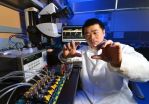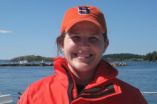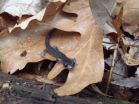(Press-News.org) COLLEGE STATION – Lab tests at Texas A&M AgriLife Research have shown that treatments with peach extract inhibit breast cancer metastasis in mice.
AgriLife Research scientists say that the mixture of phenolic compounds present in the peach extract are responsible for the inhibition of metastasis, according to the study, which was this month published in the Journal of Nutritional Biochemistry.
"Cancer cells were implanted under the skin of mice with an aggressive type of breast cancer cells, the MDA-MB-435, and what we saw was an inhibition of a marker gene in the lungs after a few weeks indicating an inhibition of metastasis when the mice were consuming the peach extract," said Dr. Luis Cisneros-Zevallos, a food scientist for AgriLife Research in College Station. "Furthermore, after determining the dose necessary to see the effects in mice, it was calculated that for humans it would be equivalent to consuming two to three peaches per day."
This is very important because it can be translated into something that is also beneficial for people, he added.
This work builds upon previous work at AgriLife Research released a few years ago, which showed that peach and plum polyphenols selectively killed aggressive breast cancer cells and not the normal ones, Cisneros-Zavallos said.
The previous work as well as the present one was conducted by Cisneros-Zevallos, Dr. David Byrne, both with AgriLife Research; Dr. Weston Porter, Texas A&M University department of veterinary physiology and pharmacology; and then-graduate student Giuliana Noratto, who is now on the faculty at Washington State University.
In the western hemisphere, breast cancer is the most common malignant disease for women, he said. In the U.S. last year, the American Cancer Society estimated about 232,340 new cases of invasive breast cancer among women.
Most of the complications and high mortality associated with breast cancer are due to metastasis, Cisneros-Zevallos pointed out.
"The importance of our findings are very relevant, because it shows in vivo the effect that natural compounds, in this case the phenolic compounds in peach, have against breast cancer and metastasis. It gives opportunity to include in the diet an additional tool to prevent and fight this terrible disease that affects so many people," he said.
The study was conducted using the peach variety Rich Lady. However, according to Cisneros-Zevallos, most peach fruit share similar polyphenolic compounds but might differ in content. The study also determined that the underlying mechanism by which peach polyphenols are inhibiting metastasis would be by targeting and modulating the gene expression of metalloproteinases.
"In general, peach fruit has chemical compounds that are responsible for killing cancer cells while not affecting normal cells as we reported previously, and now we are seeing that this mixture of compounds can inhibit metastasis," said Cisneros-Zevallos. "We are enthusiastic about the idea that perhaps by consuming only two to three peaches a day we can obtain similar effects in humans. However, this will have to be the next step in the study for its confirmation."
Cisneros-Zevallos continues testing these extracts and compounds in different types of cancer as well as in diabetes studies in vitro and in vivo to understand the molecular mechanisms involved.
INFORMATION:
The work documenting the health benefits of stone fruit has been supported by the Vegetable and Fruit Improvement Center at Texas A&M, the U.S. Department of Agriculture and the California Tree Fruit Agreement.
Texas researcher: Peaches inhibit breast cancer metastasis in mice
2014-03-25
ELSE PRESS RELEASES FROM THIS DATE:
Robotic arm probes chemistry of 3-D objects by mass spectrometry
2014-03-25
VIDEO:
In early tests, the research team used a Kuka KR5 sixx R650 robot, seen in action here.
Click here for more information.
When life on Earth was first getting started, simple molecules bonded together into the precursors of modern genetic material. A catalyst would have been needed, but enzymes had not yet evolved. One theory is that the catalytic minerals on a meteorite's surface could have jump-started life's first chemical reactions. But scientists need a way to directly ...
JCI online ahead of print table of contents for March 25, 2014
2014-03-25
Epigenetic alterations disrupt intestinal T cell homeostasis
A precise balance between mature T cell subsets is important for intestinal homeostasis. Disruption of T cell populations underlies autoimmune colitis, including inflammatory bowel disease (IBD). Specific transcriptional programs are activated to determine the differentiation fate of naïve T cells; however, the role of epigenetic regulation in T cell maturation in the intestine is unclear. In this issue of the Journal of Clinical Investigation, Colby Zaph and colleagues from the University of British Columbia ...
Salamanders shrinking as their mountain havens heat up
2014-03-25
Wild salamanders living in some of North America's best salamander habitat are getting smaller as their surroundings get warmer and drier, forcing them to burn more energy in a changing climate.
That's the key finding of a new study, published March 25 in the journal Global Change Biology, that examined museum specimens caught in the Appalachian Mountains from 1957 to 2007 and wild salamanders measured at the same sites in 2011-2012. The salamanders studied from 1980 onward were, on average, 8% smaller than their counterparts from earlier decades. The changes were most ...
ISU engineer builds instrument to study effects of genes, environment on plant traits
2014-03-25
AMES, Iowa – Let's say plant scientists want to develop new lines of corn that will better tolerate long stretches of hot, dry weather.
How can they precisely assess the performance of those new plants in different environmental conditions? Field tests can provide some answers. Greenhouse tests can provide some more. But how can plant scientists get a true picture of a plant's growth and traits under a wide variety of controlled environmental conditions?
That job has been too big and too precise for most laboratories. There are a few labs around the world that can ...
SU biologists use sound to identify breeding grounds of endangered whales
2014-03-25
Remote acoustic monitoring among endangered whales is the subject of a major article by two doctoral students in Syracuse University's College of Arts and Sciences.
Leanna Matthews and Jessica McCordic, members of the Parks Lab in the Department of Biology, have co-authored "Remote Acoustic Monitoring of North Atlantic Right Whales Reveals Seasonal and Diel Variations in Acoustic Behavior." The article appears in the current issue of PLOS ONE, an inclusive, peer-reviewed, open-access resource from the Public Library of Science in San Francisco, Calif.
Susan Parks, assistant ...
In search of a few good apps
2014-03-25
BOSTON–While the Food and Drug Administration (FDA) has released guidelines for the regulation of mobile health (mHealth) apps that act as medical devices or as accessories to medical devices, the vast majority of mHealth apps remain unregulated and unevaluated. In a Viewpoint article, "In Search of a Few Good Apps", published in JAMA on March 24, 214, co-authors, David Bates, MD and Adam Landman, MD of Brigham and Women's Hospital (BWH) and Adam Powell, PhD, president of Payer+Provider Syndicate, call for the creation of mHealth (mobile health) app review and certification ...
Study: Salamanders shrinking due to climate change
2014-03-25
Wild salamanders living in some of North America's best salamander habitat are getting smaller as their surroundings get warmer and drier, forcing them to burn more energy in a changing climate.
That's the key finding of a new study co-authored by a Clemson University biologist and published Tuesday in the journal Global Change Biology that examined museum specimens caught in the Appalachian Mountains from 1957 to 2007 and wild salamanders measured at the same sites in 2011-2012.
The salamanders studied from 1980 onward were, on average, eight percent smaller than their ...
Nanotube coating helps shrink mass spectrometers
2014-03-25
WEST LAFAYETTE, Ind. — Nanotechnology is advancing tools likened to Star Trek's "tricorder" that perform on-the-spot chemical analysis for a range of applications including medical testing, explosives detection and food safety.
Researchers found that when paper used to collect a sample was coated with carbon nanotubes, the voltage required was 1,000 times reduced, the signal was sharpened and the equipment was able to capture far more delicate molecules.
A team of researchers from Purdue University and the Indian Institute of Technology Madras performed the study, which ...
Model predicts blood glucose levels 30 minutes later
2014-03-25
A mathematical model created by Penn State researchers can predict with more than 90 percent accuracy the blood glucose levels of individuals with type 1 diabetes up to 30 minutes in advance of imminent changes in their levels -- plenty of time to take preventative action.
"Many people with type 1 diabetes use continuous glucose monitors, which examine the fluid underneath the skin," said Peter Molenaar, Distinguished Professor of Human Development and Family Studies and of psychology. "But the glucose levels under the skin trail blood glucose levels from anywhere between ...
NASA satellite sees wind shear whipping Tropical Cyclone Gillian
2014-03-25
A visible image from NASA's Aqua satellite provides a clear picture that wind shear is responsible for weakening the once mighty Tropical Cyclone Gillian from hurricane to tropical storm strength.
When NASA's Aqua satellite flew over Gillian on March 25 at 06:30 UTC/2:30 a.m. EDT, the Moderate Resolution Imaging Spectroradiometer or MODIS instrument took a visible picture of the storm. That image showed that wind shear has pushed clouds and showers away from the center as the storm weakened to a tropical storm.
In the MODIS image, the center of Gillian's circulation ...







